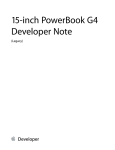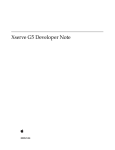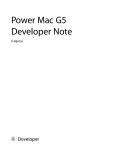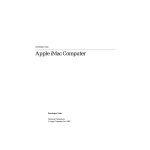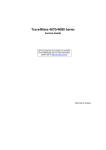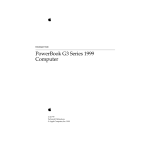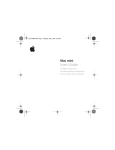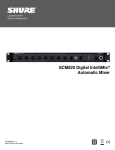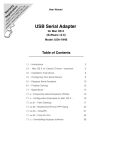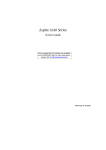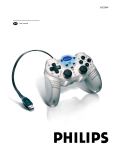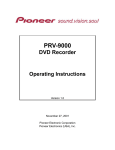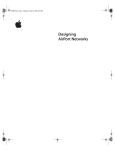Download Apple 17-INCH Laptop User Manual
Transcript
PowerBook G4 17-inch (Legacy) 2003-03-01 Apple Inc. © 2003 Apple Computer, Inc. All rights reserved. No part of this publication may be reproduced, stored in a retrieval system, or transmitted, in any form or by any means, mechanical, electronic, photocopying, recording, or otherwise, without prior written permission of Apple Inc., with the following exceptions: Any person is hereby authorized to store documentation on a single computer for personal use only and to print copies of documentation for personal use provided that the documentation contains Apple’s copyright notice. The Apple logo is a trademark of Apple Inc. No licenses, express or implied, are granted with respect to any of the technology described in this document. Apple retains all intellectual property rights associated with the technology described in this document. This document is intended to assist application developers to develop applications only for Apple-labeled computers. Apple Inc. 1 Infinite Loop Cupertino, CA 95014 408-996-1010 Apple, the Apple logo, AirPort, AirPort Extreme, eMac, FireWire, Instruments, Mac, Mac OS, Macintosh, PowerBook, SuperDrive, and Velocity Engine are trademarks of Apple Inc., registered in the United States and other countries. DEC is a trademark of Digital Equipment Corporation. GeForce4 is a trademark of NVIDIA Corporation. Intel and Intel Core are registered trademarks of Intel Corportation or its subsidiaries in the United States and other countries. OpenGL is a registered trademark of Silicon Graphics, Inc. PowerPC and and the PowerPC logo are trademarks of International Business Machines Corporation, used under license therefrom. Even though Apple has reviewed this document, APPLE MAKES NO WARRANTY OR REPRESENTATION, EITHER EXPRESS OR IMPLIED, WITH RESPECT TO THIS DOCUMENT, ITS QUALITY, ACCURACY, MERCHANTABILITY, OR FITNESS FOR A PARTICULAR PURPOSE. AS A RESULT, THIS DOCUMENT IS PROVIDED “AS IS,” AND YOU, THE READER, ARE ASSUMING THE ENTIRE RISK AS TO ITS QUALITY AND ACCURACY. IN NO EVENT WILL APPLE BE LIABLE FOR DIRECT, INDIRECT, SPECIAL, INCIDENTAL, OR CONSEQUENTIAL DAMAGES RESULTING FROM ANY DEFECT OR INACCURACY IN THIS DOCUMENT, even if advised of the possibility of such damages. THE WARRANTY AND REMEDIES SET FORTH ABOVE ARE EXCLUSIVE AND IN LIEU OF ALL OTHERS, ORAL OR WRITTEN, EXPRESS OR IMPLIED. No Apple dealer, agent, or employee is authorized to make any modification, extension, or addition to this warranty. Some states do not allow the exclusion or limitation of implied warranties or liability for incidental or consequential damages, so the above limitation or exclusion may not apply to you. This warranty gives you specific legal rights, and you may also have other rights which vary from state to state. Contents Introduction Introduction to PowerBook G4 17-inch 9 Organization of This Document 9 Chapter 1 Overview of PowerBook G4 17-inch 11 PowerBook G4 17-inch Features 11 Appearance 12 Peripheral Devices 14 System Software 14 Open Firmware 14 Computer Identification 14 Power Saving Features 15 Chapter 2 Architecture 17 Block Diagram and Buses 17 Block Diagram 17 Main ICs and Buses 18 Microprocessor and Caches 18 PowerPC G4 Microprocessor 18 Level 2 Cache 19 Level 3 Cache 19 Intrepid Controller and Buses 19 System RAM 20 Boot ROM 20 FireWire Controllers 20 Ethernet Controller 20 Video Display Subsystem 20 I/O Controller 21 DMA Support 21 Interrupt Support 22 USB Interface 22 Ultra ATA-100 Interface 22 ATA-33 Interface 22 Modem Support 22 Sound Circuitry 23 Power Controller 23 AirPort Extreme Interface 23 CardBus Controller IC 24 3 Legacy Document | 2003-03-01 | © 2003 Apple Computer, Inc. All Rights Reserved. CONTENTS Chapter 3 Devices and Ports 25 USB Ports 25 USB Connectors 25 USB Storage Devices 26 FireWire Ports 26 FireWire 400 Connector 26 FireWire 800 Connector 27 Booting from a FireWire Device 29 Target Disk Mode 29 Ethernet Port 29 Internal Modem 30 AirPort Extreme 31 Data Security 31 AirPort Extreme Hardware 32 AirPort Extreme Software 32 Bluetooth Technology 32 Hard Disk Drive 33 Hard Disk Dimensions 33 Hard Disk Connector 34 SuperDrive (DVD-R /CD-RW) 37 Trackpad 38 Keyboard 38 Changing the Operation of the Keyboard 39 Flat-Panel Display 44 External Monitors 45 Dual Display and Mirror Mode 45 Analog Monitor Resolutions 45 Digital Display Resolutions 46 DVI-I Connector 46 External Video Port 48 Sound System 49 Sound Inputs 49 Sound Outputs 50 Digitizing Sound 51 Chapter 4 Expansion Features 53 RAM Expansion Slots 53 Accessing the RAM Slots 53 Mechanical Design of DDR RAM SO-DIMMs 54 Electrical Design of DDR RAM SO-DIMMs 54 RAM SO-DIMM Electrical Limits 56 CardBus Slot 57 4 Legacy Document | 2003-03-01 | © 2003 Apple Computer, Inc. All Rights Reserved. CONTENTS Appendix A Supplemental Reference Documents 59 Apple Technical Notes 59 3D Graphics 59 PowerPC G4 Microprocessor 59 Velocity Engine (AltiVec) 60 Mac OS X 60 I/O Kit 60 Open Firmware 60 RAM Expansion Modules 61 PC Card Manager 61 ATA Devices 62 USB Interface 62 FireWire Interface 62 Digital Visual Interface 63 Wireless Networks 63 Bluetooth 63 Appendix B Abbreviations 65 Abbreviations and Standard Units 65 Other Abbreviations 65 5 Legacy Document | 2003-03-01 | © 2003 Apple Computer, Inc. All Rights Reserved. CONTENTS 6 Legacy Document | 2003-03-01 | © 2003 Apple Computer, Inc. All Rights Reserved. Figures and Tables Chapter 1 Overview of PowerBook G4 17-inch 11 Figure 1-1 Figure 1-2 Chapter 2 Architecture 17 Figure 2-1 Table 2-1 Chapter 3 Front view of the computer 13 Side views showing I/O ports 13 Block diagram 17 Buses supported by the Intrepid IC 19 Devices and Ports 25 Figure 3-1 Figure 3-2 Figure 3-3 Figure 3-4 Figure 3-5 Figure 3-6 Figure 3-7 Figure 3-8 Figure 3-9 Figure 3-10 Table 3-1 Table 3-2 Table 3-3 Table 3-4 Table 3-5 Table 3-6 Table 3-7 Table 3-8 Table 3-9 Table 3-10 Table 3-11 Table 3-12 Table 3-13 Table 3-14 Table 3-15 Table 3-16 Table 3-17 Table 3-18 USB Type A port 25 6-pin FireWire connector 27 9-pin FireWire 800 connector 28 Maximum dimensions of the internal hard disk 34 Hard disk connector and location 35 Keyboard layout 39 Alternate operations of function and control keys 40 Embedded numeric keypad operation 41 DVI-I connector 47 S-video connector 48 Pin assignments on the USB port 25 Pin assignments on the 6-pin FireWire connector 27 Signals on the 9-pin FireWire 800 connector 28 Signals for 10Base-T and 100Base-T operation 29 Signals for 1000Base-T operation 30 Pin assignments on the ATA hard disk connector 35 Signals on the ATA hard disk connector 36 Media read and written by the SuperDrive 37 The function keys as control buttons 42 Embedded keypad keys 43 Control keys that change 43 Picture sizes on the flat-panel display 44 Picture sizes on an analog monitor 45 Picture sizes on a digital display 46 Main signals on the DVI-I connector 47 MicroCross signals on the DVI-I connector 47 Pin assignments for the S-video output connector 48 Picture sizes for S-video output 48 7 Legacy Document | 2003-03-01 | © 2003 Apple Computer, Inc. All Rights Reserved. FIGURES AND TABLES Chapter 4 Expansion Features 53 Figure 4-1 Table 4-1 Table 4-2 Removing RAM expansion slot cover 53 Sizes of RAM expansion modules and devices Types of DRAM devices 56 8 Legacy Document | 2003-03-01 | © 2003 Apple Computer, Inc. All Rights Reserved. 55 INTRODUCTION Introduction to PowerBook G4 17-inch Important: The information in this document is obsolete and should not be used for new development. Links to downloads and other resources may no longer be valid. This developer note is a technical description of the PowerBook G4 17-inch computer. The note provides information about the computer’s internal design, input-output features, and expansion capabilities. This developer note is intended to help hardware and software developers design products that are compatible with the Macintosh products described here. If you are not already familiar with Macintosh computers or if you would like additional technical information, you may wish to read the supplementary reference documents described in Appendix A (page 59). Organization of This Document The information in this note is arranged in four chapters and two appendixes. ● Chapter 1, “Introduction”, (page 11) introduces the PowerBook G4 17-inch computer and describes its features. ● Chapter 2, “Architecture”, (page 17) describes the internal logic of the computer, including the main ICs that appear in the block diagram. ● Chapter 3, “Devices and Ports”, (page 25) describes the standard I/O ports and the built-in I/O devices. ● Chapter 4, “Expansion Features”, (page 53) describes the expansion features of interest to developers. It includes development guides for expansion-bay devices, the RAM expansion modules, and the PC Card slot. ● Appendix A (page 59) contains links to supplemental reference documents. ● Appendix B (page 65) is a list of the abbreviations used in this developer note. Organization of This Document Legacy Document | 2003-03-01 | © 2003 Apple Computer, Inc. All Rights Reserved. 9 INTRODUCTION Introduction to PowerBook G4 17-inch 10 Organization of This Document Legacy Document | 2003-03-01 | © 2003 Apple Computer, Inc. All Rights Reserved. CHAPTER 1 Overview of PowerBook G4 17-inch This chapter outlines the features of the PowerBook G4 17-inch computer. PowerBook G4 17-inch Features Here is a list of the features of the PowerBook G4 17-inch computer. Each feature is described in a later chapter, as indicated. ● Processor The computer has a PowerPC G4 microprocessor running at a clock speed of 1 GHz. For more information, see “PowerPC G4 Microprocessor” (page 18). ● System bus The speed of the system bus is 167 MHz. ● Cache location and speed In addition to the L2 cache, which is internal to the processor IC, the computer also has a 1MB 5:1 L3 cache. See “Level 2 Cache” (page 19) and “Level 3 Cache” (page 19). ● RAM The computer has two standard PC2700 (333 MHz) DDR SO-DIMM expansion slots for SDRAM modules. The computer comes with 512 MB of SDRAM installed in one slot. See “RAM Expansion Slots” (page 53). ● ROM The computer has 1 MB of boot ROM used by Open Firmware at startup. For information about the ROM, see “Boot ROM” (page 20). For information about Open Firmware, see “Open Firmware” (page 60). ● Hard disk storage The computer comes with a built-in hard disk drive with a capacity of 60 GB. For more information, see “Hard Disk Drive” (page 33). ● Display The display is a 100 dpi,17 inch wide-screen TFT with a resolution of 1440x900. See “Flat-Panel Display” (page 44). ● External monitor The computer supports an external video monitor, using the DVI connector for a digital video display and an S-video connector for a PAL or NTSC video monitor. Included with the computer are a DVI-to-VGA adapter and an S-video-to-composite adapter; a DVI-to-ADC Apple Display Connector adapter is available separately. See “External Monitors” (page 45). ● Graphics IC and memory The nVidia GeForce4 440 Go graphics controller operates on the AGP-4x bus along with 64 MB of DDR video SRAM. For more information, see “Video Display Subsystem” (page 20). ● Battery bay The computer has a single battery bay. The battery uses lithium ion cells and provides 55 watt-hours at 10.8 V (nominal) for up to 4.5 hours. ● Power adapter The computer comes with a 65 W power adapter with safety ground. ● SuperDrive (DVD-R/CD-RW drive) The computer has a built-in DVD-R/CD-RW SuperDrive drive. For more information, see “SuperDrive (DVD-R /CD-RW)” (page 37). PowerBook G4 17-inch Features Legacy Document | 2003-03-01 | © 2003 Apple Computer, Inc. All Rights Reserved. 11 CHAPTER 1 Overview of PowerBook G4 17-inch ● CardBus slot The computer has a CardBus slot that accepts one Type I or Type II PC Card or a CardBus Card. For more information, see “CardBus Slot” (page 57). ● USB ports The computer has two USB 1.1 ports for an external keyboard, a mouse, and other USB devices, described in “USB Ports” (page 25). ● FireWire ports The computer has one IEEE-1394a 400 Mbps serial FireWire 400 port and one IEEE-1394b 800 Mbps serial FireWire 800 port. For more information, see “FireWire Ports” (page 26). ● Target disk mode The PowerBook G4 17-inch computer can act like a FireWire storage device connected to another computer. See “Target Disk Mode” (page 29). ● Modem The computer has a built-in modem with 56 Kbps data rate and V.34, V.90, and V.92 support. For more information, see “Internal Modem” (page 30). ● Ethernet The computer has a built in Ethernet port with an RJ-45 connector for 10Base-T, 100Base-T, and 1000Base-T operation. For more information, see “Ethernet Port” (page 29). ● AirPort Extreme The fully-integrated, 54 Mbps AirPort Extreme provides a wireless LAN connection. For more information, see “AirPort Extreme” (page 31). ● Bluetooth support Fully-integrated Bluetooth support enables short-range wireless connections between desktop and laptop computers and a host of other peripheral devices. For more information, see “Bluetooth Technology” (page 32). ● Sound The computer has a built-in microphone, stereo speakers, a stereo headphone jack, and a sound input jack. See “Sound System” (page 49). ● Keyboard The keyboard has an embedded numeric keypad and inverted-T arrow keys. Some of the function keys are used to control the display brightness and speaker volume. See “Keyboard” (page 38). ● Trackpad The integrated trackpad includes tap/double-tap and drag features and palm-rejection capabilities. For more information, see “Trackpad” (page 38). ● Weight The basic configuration weighs 6.8 pounds. ● Size The computer is 15.4 inches (39.2 cm ) wide, 10.2 inches (25.9 cm) deep, and 1.0 inches (2.6 cm) thick. ● Illuminated keyboard The computer has a backlit keyboard for optimal usability in all lighting conditions. For more information, see “Keyboard” (page 38). ● Ambient light sensor The computer has an ambient light sensor which monitors light levels and activates the illuminated backlit keyboard and adjusts the display brightness. Appearance Figure 1-1 (page 13) is a front view of the PowerBook G4 17-inch computer. Figure 1-2 (page 13) provides side views showing the I/O ports. 12 Appearance Legacy Document | 2003-03-01 | © 2003 Apple Computer, Inc. All Rights Reserved. CHAPTER 1 Overview of PowerBook G4 17-inch Figure 1-1 Front view of the computer Figure 1-2 Side views showing I/O ports Appearance Legacy Document | 2003-03-01 | © 2003 Apple Computer, Inc. All Rights Reserved. 13 CHAPTER 1 Overview of PowerBook G4 17-inch Peripheral Devices Included with the computer are a 65 W Apple Portable Power Adapter, an S-video-to-composite cable, and a DVI-to-VGA cable. In addition to these devices, the following peripheral devices are available separately: ● The PowerBook G4 Rechargeable Battery is available as an additional or replacement battery. ● The 65 W Apple Portable Power Adapter, which comes with the computer, is also available separately. The adapter can fully recharge a completely depleted battery in three hours or less while the computer is shut down or in sleep mode. ● The Apple DVI to ADC Adapter, which enables the PowerBook G4 17-inch computer to support Apple’s ADC displays. ● The Apple Pro Keyboard, a full-featured USB keyboard. ● The Apple Pro Mouse, an optical USB mouse. ● The AirPort Extreme Base Station. ● A power cable for use on airliners is also available. The airline power cable should have a sense resistor of 24.3 K ohms +/-5% connected between the power plug's shell and ground. For more information, see “Power Controller” (page 23). System Software The PowerBook G4 17-inch computer comes with Mac OS X version 10.2. For the latest information, see the references listed in “Mac OS X” (page 60). Here are a few items of interest about the system software on the PowerBook G4 17-inch computer. Open Firmware System software on all current Macintosh models uses a design based on Open Firmware. With this approach, the ROM on the main logic board contains only the Open Firmware code needed to initialize the hardware and load an operating system. The rest of the system code is loaded into RAM from disk or from the network. For more information, see the references listed in “Open Firmware” (page 60). Computer Identification Rather than reading the box flag or the model string and then making assumptions about the computer’s features, applications that need to find out the features of the computer should use IORegistry calls to test for the features they require. IORegistry calls are part of the I/O Kit API. For more information, see the references listed at “I/O Kit” (page 60). 14 Peripheral Devices Legacy Document | 2003-03-01 | © 2003 Apple Computer, Inc. All Rights Reserved. CHAPTER 1 Overview of PowerBook G4 17-inch Asset management software that reports the kind of computer it is running on can obtain the value of the model property from the IOService plane of the IORegistry. For the PowerBook G4 17-inch computer, the value of the model property is PowerBook5,1. Power Saving Features The PowerBook G4 17-inch computer has several profiles to save power. These profiles are labeled on the Energy Saver panel of System Preferences. Reduced Processor Performance The PowerBook G4 17-inch computer reduces both processor speed and voltage to save power. Reduced processor speed allows the software to change the processor’s clock speed, slowing down to conserve power or speeding up when more speed is needed. The slower clock speed is 667 MHz and the L3 cache is turned off. The user interface for the reduced processor speed is located in the options tab under the Energy Saver panel in System Preferences. Operating Modes The power management protocols on the PowerBook G4 17-inch computer support two power-saving modes: idle and sleep. ● Idle: The system is idling with the main processor stopped in a halted, low-power state. All clocks are running; the system can return to running code within a few nanoseconds. Cache coherency is maintained in this state. ● Sleep: The system is completely shut down, with only the DRAM state preserved for quick recovery. All processors are powered off with their state preserved in DRAM. All clocks in the system are suspended except for the 32.768 kHz timebase crystal on the PMU99 IC. The computer automatically enters idle mode after several seconds of inactivity. If the computer is attached to a network, it is able to respond to service requests and other events directed to the computer while it is in idle mode. While it is connected to an AC power supply, the computer can also respond to network activity when it is in sleep mode. The user can enable this feature by selecting Wake-on-LAN in the Energy Saver panel of System Preferences. When operating on the battery in sleep mode, the computer consumes less than 1 watt of power, meeting the Energy Star power-saving standard. When operating on the power adapter in sleep mode, the combined computer and adapter consume 3 to 4 watts of power. Important: Peripherals such as PCMCIA cards and USB devices that do not conform to the computer’s power management protocols prevent the computer from switching to sleep mode and so deny the user the benefits of this energy-saving mode. When such peripherals are attached to the computer, the operating system displays a dialog to inform the user that the computer no longer meets the Energy Star requirements. System Software Legacy Document | 2003-03-01 | © 2003 Apple Computer, Inc. All Rights Reserved. 15 CHAPTER 1 Overview of PowerBook G4 17-inch 16 System Software Legacy Document | 2003-03-01 | © 2003 Apple Computer, Inc. All Rights Reserved. CHAPTER 2 Architecture This chapter describes the architecture of the PowerBook G4 17-inch computer. It includes information about the major components on the main logic board: the microprocessor, the other main ICs, and the buses that connect them to each other and to the I/O interfaces. Block Diagram and Buses This section is an overview of the major ICs and buses on the computer’s main logic board. Block Diagram Figure 2-1 (page 17) is a simplified block diagram of the main logic board. The diagram shows the input and output connectors, the main ICs, and the buses that connect them together. Figure 2-1 Block diagram Block Diagram and Buses Legacy Document | 2003-03-01 | © 2003 Apple Computer, Inc. All Rights Reserved. 17 CHAPTER 2 Architecture Main ICs and Buses The architecture of the PowerBook G4 17-inch computer is designed around the PowerPC G4 microprocessor and Intrepid IC that contains the memory controller and I/O device controller. The PowerPC G4 microprocessor is connected to the Intrepid IC by a MaxBus bus. The bus clock speed is 167 MHz. Other buses that connect with the Intrepid IC are summarized in Table 2-1 (page 19), which is in the section “Intrepid Controller and Buses” (page 19). The Intrepid I/O controller has a 32-bit PCI bus with a bus clock speed of 33 MHz. That bus also connects to the Boot ROM and the CardBus controller. The Intrepid IC has other buses that connect with the hard disk drive and the optical drive, the power controller IC, the sound IC, the internal modem module, and the wireless LAN module. Each of the components listed here is described in one of the following sections. Microprocessor and Caches The microprocessor communicates with the rest of the system by way of a 64-bit MaxBus bus to the Intrepid IC. The microprocessor has a separate bus to its internal second-level cache. PowerPC G4 Microprocessor The PowerPC G4 microprocessor used in the PowerBook G4 17-inch computer has many powerful features, including an efficient pipelined system bus called MaxBus. Features of the PowerPC G4 include ● 32-bit PowerPC implementation ● superscalar PowerPC core ● Velocity Engine (AltiVec technology): 128-bit-wide vector execution unit ● dual 32 KB instruction and data caches ● an on-chip level 2 (L2) cache consisting of 256 KB with a clock speed ratio of 1:1 ● high bandwidth MaxBus (also compatible with 60x bus) ● fully symmetric multiprocessing capability The PowerPC G4 microprocessor in the PowerBook G4 17-inch computer runs at a clock speed of 1 GHz. 18 Microprocessor and Caches Legacy Document | 2003-03-01 | © 2003 Apple Computer, Inc. All Rights Reserved. CHAPTER 2 Architecture Level 2 Cache The data storage for the L2 cache consists of 256 KB of fast static RAM that is built into the microprocessor chip along with the cache controller and tag storage. The built-in L2 cache runs at the same clock speed as the microprocessor. Level 3 Cache The data storage for the L3 cache is 1 MB of DDR SRAM running at a clock speed ratio of 5:1. The tag storage for the L3 cache is built into the microprocessor. Intrepid Controller and Buses The Intrepid IC provides cost and performance benefits by combining several functions into a single IC. It contains the memory controller, the PCI bus bridge, the Ethernet and FireWire interfaces, and the AGP interface. Each of the separate communication channels in the Intrepid IC can operate at its full capacity without degrading the performance of the other channels. In addition to the buses listed in Table 2-1 (page 19), the Intrepid IC also has separate interfaces to the physical layer (PHY) ICs for Ethernet and FireWire, and an IIC (inter-IC control bus) interface that is used for configuring the memory subsystem. Table 2-1 Buses supported by the Intrepid IC Bus Destinations Width of data path Bus clock speed MaxBus Microprocessor 64 bits 167 MHz Memory System RAM 64 bits 333 MHz PCI AirPort Extreme, CardBus, Boot ROM 32 bits 33 MHz AGP4X Graphics IC 32 bits 66 MHz Ultra ATA-100 Hard drive 16 bits 100 Mbps ATA-33 SuperDrive 16 bits 33 MHhz The microprocessor and the I/O controller IC are described in their own sections. The following sections describe the other subsystems that are connected to the Intrepid IC. Intrepid Controller and Buses Legacy Document | 2003-03-01 | © 2003 Apple Computer, Inc. All Rights Reserved. 19 CHAPTER 2 Architecture System RAM The memory subsystem in the PowerBook G4 17-inch computer supports two slots for 333 MHz DDR (PC2700) SO-DIMMs (small-outline dual inline memory modules). The data bus to the RAM and DIMM is 64 bits wide, and the memory interface is synchronized to the MaxBus bus interface at 167 MHz. See “RAM Expansion Slots” (page 53). Boot ROM The boot ROM is connected to the Intrepid IC by way of the high byte of the PCI bus plus three additional control signals: chip select, write enable, and output enable. The boot ROM is a 1 MB by 8 bit device. FireWire Controllers The Intrepid IC FireWire controller supports IEEE 1394a for a maximum data rate of 400 Mbps (50 MBps) and IEEE 1394b for a maximum data rate of 800 Mbps (100 MBps). The Intrepid IC provides DMA (direct memory access) support for the FireWire interface. The controller in the Intrepid IC implements the FireWire link layer. A physical layer IC, called a PHY, implements the electrical signaling protocol of the FireWire interface and provides the electrical signals to the port. For more information, see “FireWire 400 Connector” (page 26) and “FireWire 800 Connector” (page 27). Ethernet Controller The Intrepid IC includes an Ethernet media access controller (MAC) that implements the link layer. The Intrepid IC provides DB-DMA support for the Ethernet interface. The Ethernet controller in the Intrepid IC is connected to a PHY interface IC that provides the electrical signals to the port. The PHY is capable of operating in either 10Base-T, 100Base-T, or 1000Base-T mode: The actual speed of the link is automatically negotiated by the PHY and the bridge or router to which it is connected. For more information, see “Ethernet Port” (page 29). The PHY supports Auto-MDIX, which allows the use of straight-through cables in crossover situations (and conversely). For more information, see “Ethernet Port” (page 29). Video Display Subsystem The video display subsystem contains the graphics controller IC along with 64 MB of DDR SDRAM memory. The graphics IC, an nVidia GeForce4 440 Go, contains 2D and 3D acceleration engines, front-end and back-end scalers, a CRT controller, and an AGP4x bus interface with bus master capability. The features of the nVidia GeForce4 440 Go include 20 ● graphics processor clock speed of 189 MHz ● memory clock speed of 202.5 MHz Intrepid Controller and Buses Legacy Document | 2003-03-01 | © 2003 Apple Computer, Inc. All Rights Reserved. CHAPTER 2 Architecture ● support for 64 MB of DDR video memory with 128-bit interface ● 2D and 3D graphics acceleration ● transform acceleration ● lighting acceleration ● video acceleration ● support for MPEG decoding ● support for video mirror mode ● support for dual-display mode ● S-video output for a TV monitor The interface between the graphics IC and the rest of the system is an AGP4x (accelerated graphics port, quadruple speed) bus on the Intrepid IC. The AGP bus has 32 data lines, a clock speed of 66 MHz, and supports deeply pipelined read and write operations. The graphics IC uses a graphics address remapping table (GART) to translate AGP logical addresses into physical addresses. The graphics driver software can allocate memory in both the graphics SDRAM and the main memory. The graphics IC supports the internal flat-panel display and an external monitor. The external monitor can either mirror the built-in display or show additional desktop space (dual-display mode). For information about the displays and supported resolutions, see “Flat-Panel Display” (page 44) and “External Monitors” (page 45). I/O Controller The I/O controller IC in the PowerBook G4 17-inch computer is a custom IC called Intrepid. It provides the interface and control signals for the devices and functions described in the following sections. Note: In the device tree, the I/O controller is named “mac-io”. DMA Support The Intrepid IC provides DB-DMA (descriptor-based direct memory access) support for the following I/O channels: ● Ultra DMA ATA interface to the the internal hard drive ● modem slot interface to the built-in modem ● IIS channel to the sound IC I/O Controller Legacy Document | 2003-03-01 | © 2003 Apple Computer, Inc. All Rights Reserved. 21 CHAPTER 2 Architecture The DB-DMA system provides a scatter-gather process based on memory resident data structures that describe the data transfers. The DMA engine is enhanced to allow bursting of data files for improved performance. Interrupt Support The Intrepid IC has an interrupt controller (MPIC) that handles interrupts generated within the IC as well as external interrupts, such as those from the Ethernet and FireWire controllers. USB Interface The Intrepid IC implements three independent USB controllers (root hubs), two of which are each connected to one of the ports on the side of the computer. The use of independent controllers allows both USB ports to support high data rate devices at the same time with no degradation of their performance. If a user connects a high-speed (12 Mbps) device to one port and another high-speed device to the other, both devices can operate at their full data rates. The third independent USB controller supports the internal modem and Bluetooth modules. The two external USB connectors support USB devices with data transfer rates of 1.5 MBps (12 Mbps). For more information about the connectors, see “USB Connectors” (page 25). USB devices connected to the PowerBook G4 17-inch computer are required to support USB-suspend mode as defined in the USB specification. Information about the operation of USB-suspend mode on Macintosh computers is included in the Mac OS USB DDK API Reference. To obtain it, see the reference at “USB Interface” (page 62). The USB ports on the PowerBook G4 17-inch computer comply with the Universal Serial Bus Specification 1.1 Final Draft Revision. The USB controllers comply with the Open Host Controller Interface (OHCI) specification. Ultra ATA-100 Interface The Intrepid IC provides an Ultra ATA-100 channel that is connected to the internal hard disk drive. The Intrepid IC provides DB-DMA (descriptor-based direct memory access) support for the ATA-100 interface. The internal hard disk drive is connected as device 0 (master) in an ATA Device 0/1 configuration. For more information, see “Hard Disk Drive” (page 33). ATA-33 Interface The Intrepid IC provides an ATA bus that supports the SuperDrive (DVD-R/CD-RW) drive and the wireless LAN module. The SuperDrive is an ATAPI drive and is device-selected as master in an ATA device configuration. Modem Support The internal modem is connected to an internal USB port. The Intrepid IC provides DB-DMA support for the modem interface. The modem provides digital call progress signals to the sound circuitry. 22 I/O Controller Legacy Document | 2003-03-01 | © 2003 Apple Computer, Inc. All Rights Reserved. CHAPTER 2 Architecture The internal modem is a separate module that contains the data pump IC and the interface to the telephone line (DAA). For more information about the modem, see “Internal Modem” (page 30). Sound Circuitry The sound circuitry, called Snapper, is connected to the Intrepid IC by a standard IIS (inter-IC sound) bus. The Intrepid IC provides DB-DMA (descriptor-based direct memory access) support for the IIS port. Note: In the device tree, the sound circuitry is named “sound”. The Snapper circuitry includes a signal processing IC that handles the equalization and volume control functions, a codec IC that performs A-to-D and D-to-A conversion, and a power amplifier that drives the headphone jack. All audio is handled digitally inside the computer. The Snapper circuitry performs digital-to-analog conversion for the audio signals to the internal speakers and the headphone jack. For a description of the features of the sound system, see “Sound System” (page 49). Power Controller The PowerBook G4 17-inch computer can operate from a 15 volt power outlet on an airline, but for safety reasons, the computer will not allow battery charging. In order for the computer to detect the connection to airline power, the airline power cable should have a sense resistor of 24.3 K ohms +/-1% connected between the power plug's shell and ground. The PowerBook G4 17-inch computer has a variable speed fan control circuit and a thermal circuit that will force the unit into reduce-processor mode at 72 degrees Celsius and into sleep mode if the processor temperature exceeds 79 degrees Celsius. The power management controller in the PowerBook G4 17-inch computer is a custom IC called the PMU99. It supports several power-saving modes of operation, including idle, doze, and sleep. Note: In the device tree, the power controller is named “via-pmu”. A device’s ID voltage limits determines how the PMU identifies the power adapter. The PowerBook G4 17-inch computer is designed to use the 65-Watt Apple Portable Power Adapter which ships with it. Although you can use a 45-Watt Apple portable power adapter with a 17-inch PowerBook G4 computer, it may not provide sufficient power during some activities and power may be drawn temporarily from the battery. Should the battery become discharged, you may need to plug in the 65-Watt Apple Portable Power Adapter that came with the computer in order to start it up. AirPort Extreme Interface AirPort Extreme contains a media access controller (MAC), a digital signal processor (DSP), and a radio-frequency (RF) section. I/O Controller Legacy Document | 2003-03-01 | © 2003 Apple Computer, Inc. All Rights Reserved. 23 CHAPTER 2 Architecture Two antennas are built into the computer’s case. To improve reception, a diversity module between the antennas and the card measures the signal strength from both antennas and selects the stronger signal for AirPort Extreme. AirPort Extreme is based on the IEEE draft specification of the 802.11g standard. The card transmits and receives data at up to 54 Mbps and is compatible with 802.11b-standard 11 Mbps systems and older 802.11b-standard systems. For information about its operation, see “AirPort Extreme” (page 31). CardBus Controller IC The interface to the PC Card slot is connected to the PCI bus. The CardBus controller IC is a PCI1510A device made by Texas Instruments. It supports both 16-bit PC Cards and 32-bit CardBus Cards. 24 I/O Controller Legacy Document | 2003-03-01 | © 2003 Apple Computer, Inc. All Rights Reserved. CHAPTER 3 Devices and Ports This chapter describes both the built-in I/O devices and the ports for connecting external I/O devices. Each of the following sections describes an I/O port or device. USB Ports The PowerBook G4 17-inch computer has two external USB v1.1 ports that can be used to connect additional I/O devices such as a USB mouse, printers, scanners, and low-speed storage devices. The USB ports on the PowerBook G4 17-inch computer comply with the Universal Serial Bus Specification 1.1 Final Draft Revision. For more information about USB on Macintosh computers, consult the references at “USB Interface” (page 62). USB Connectors The USB ports use USB Type A connectors, which have four pins each. Two of the pins are used for power and two for data. Figure 3-1 (page 25) is an illustration of a Type A port and matching connector. Table 3-1 shows the pin assignments. Figure 3-1 Table 3-1 USB Type A port Pin assignments on the USB port Pin Signal name Description 1 VCC +5 VDC 2 D– Data – 3 D+ Data + 4 GND Ground The computer provides 5-volt power at 500 mA for each of the two ports. The USB ports support both low-speed and high-speed data transfers, at up to 1.5 Mbits per second and 12 Mbits per second, respectively. High-speed operation requires the use of shielded cables. USB Ports Legacy Document | 2003-03-01 | © 2003 Apple Computer, Inc. All Rights Reserved. 25 CHAPTER 3 Devices and Ports The PowerBook G4 17-inch computer supports all four data transfer types defined in the USB specification. USB devices can provide a remote wakeup function for the computer. The USB root hub in the computer is set to support remote wakeup whenever a device is attached to the bus. USB Storage Devices Class drivers are software components that are able to communicate with many USB devices of a particular kind. If the appropriate class driver is present, any number of compliant devices can be plugged in and start working immediately without the need to install additional software. FireWire Ports The PowerBook G4 17-inch computer has one FireWire 400 (IEEE 1394a) port and one FireWire 800 (IEEE 1394b) port. Both FireWire ports ● support booting the system from a mass storage device ● support target disk mode The two FireWire ports share a single power supply that can provide up to 14 watts total. Both ports are on the same FireWire bus and can connect to up 62 other FireWire devices. The FireWire hardware and software provided with the PowerBook G4 17-inch computer are capable of all asynchronous and isochronous transfers defined by IEEE standard 1394a and 1394b. For additional information about the FireWire interface and the Apple API for FireWire device control, refer to the resources listed at “FireWire Interface” (page 62). FireWire 400 Connector The 6-pin FireWire 400 technology ● supports serial I/O at 100, 200, and 400 Mbps ● provides up to 7 watts of power when the computer system is on or when the power adapter is connected and in sleep mode The FireWire 400 connector has six contacts, as shown in Figure 3-2 (page 27). The connector pin assignments are shown in Table 3-2 (page 27). 26 FireWire Ports Legacy Document | 2003-03-01 | © 2003 Apple Computer, Inc. All Rights Reserved. CHAPTER 3 Devices and Ports Figure 3-2 Table 3-2 6-pin FireWire connector Pin assignments on the 6-pin FireWire connector Pin Signal name Description 1 Power Unregulated DC; 12.8 V 2 Ground Ground return for power and inner cable shield 3 TPB- Twisted-pair B, differential signals 4 TPB+ Twisted-pair B, differential signals 5 TPA- Twisted-pair A, differential signals 6 TPA+ Twisted-pair A, differential signals Shell — Outer cable shield When the computer is on or the power adapter is connected, the power pin provides a maximum voltage of 12.8 V (no load) and 7 W power per port. Maximum output current for both ports combined is 1.5 A and is controlled by a self-resetting fuse. Pin 2 of the 6-pin FireWire connector is ground for both power and the inner cable shield. If a 4-pin connector is used on the other end of the FireWire cable, its shell should be connected to the wire from pin 2. The signal pairs are crossed in the cable itself so that pins 5 and 6 at one end of the cable connect with pins 3 and 4 at the other end. When transmitting, pins 3 and 4 carry data and pins 5 and 6 carry clock; when receiving, the reverse is true. FireWire 800 Connector The FireWire 800 port on the PowerBook G4 17-inch computer is based on IEEE 1394b and enables a 800 Mbps transfer rate. FireWire 800 uses a 9-pin connector and is backwards compatible with original 1394 FireWire devices with 6-pin or 4-pin connectors. With the appropriate cable, the new 9-pin port works seamlessly with legacy FireWire devices. Cables are available to go from both 6-pin and 4-pin connectors to a 9-pin, and 9-pin to 9-pin. FireWire Ports Legacy Document | 2003-03-01 | © 2003 Apple Computer, Inc. All Rights Reserved. 27 CHAPTER 3 Devices and Ports Note: FireWire adapter cables are not included with the computer. The 9-pin FireWire 800 connector is shown in Figure 3-3 (page 28). Its connector signals and pin assignments are shown in Table 3-3 (page 28). Figure 3-3 Table 3-3 9-pin FireWire 800 connector Signals on the 9-pin FireWire 800 connector Pin Signal name Description 1 TPB– Twisted-pair B Minus 2 TPB+ Twisted-pair B Plus 3 TPA– Twisted-pair A Minus 4 TPA+ Twisted-pair A Plus 5 TPA (R) Twisted-pair A Ground Reference 6 VG Power Ground 7 SC Status Contact (no connection; reserved) 8 VP Power Voltage (approximately 12.8 V DC) 9 TPB (R) Twisted-pair B Ground Reference VP (pin 8) provides up to 7 W power, shared with the other FireWire connectors. The voltage on the power pin is approximately 12.8 V. The 9-pin FireWire 800 port is capable of operating at 100, 200, 400, and 800 Mbps, depending on the device to which it is connected. The FireWire 800 port is bilingual in that it supports both IEEE 1394a and 1394b. Using a cable with a 9-pin connector at one end and a 4-pin or 6-pin connector at the other, the 9-pin port is capable of directly connecting to all existing FireWire devices. Using a cable with 9-pin connectors at both ends, the 9-pin port is capable of operating at 800 Mbps. The IEEE 1394b standard defines long-haul media using Cat 5 UTP and several kinds of optical fiber. The PowerBook G4 17-inch computer is interoperable with such cables but cannot be directly connected to them. To use long-haul cables, connect the computer to a 1394b hub that has the desired kind of long-haul connectors. If the hub has a bilingual port, that port can be connected to any of the computer’s FireWire ports. If the hub has a beta-only port, it can be connected only to the computer’s 9-pin port. 28 FireWire Ports Legacy Document | 2003-03-01 | © 2003 Apple Computer, Inc. All Rights Reserved. CHAPTER 3 Devices and Ports Booting from a FireWire Device The PowerBook G4 17-inch computer can boot from a FireWire storage device that implements SBP-2 (Serial Bus Protocol) with the RBC (reduced block commands) command set. Detailed information is available from Developer Technical Support at [email protected]. Target Disk Mode One option at boot time is to put the computer into a mode of operation called target disk mode. When the PowerBook G4 17-inch computer is in target disk mode and connected to another Macintosh computer by a FireWire cable, the PowerBook G4 17-inch computer operates like a FireWire mass storage device with the SBP-2 (Serial Bus Protocol) standard. Target disk mode has two primary uses: ● high-speed data transfer between computers ● diagnosis and repair of a corrupted internal hard drive The PowerBook G4 17-inch computer can operate in target disk mode as long as the other computer has a FireWire 1394a or 1394b port and is running either Mac OS X (any version) or Mac OS 9 with FireWire software version 2.3.3 or later. To put the computer into target disk mode, hold down the T key while the computer is starting up. When Open Firmware detects the T key during the boot process, it transfers control to special Open Firmware code. To take the computer out of target disk mode, press the power button. When running target disk mode from a PowerBook G4 17-inch computer using a 45 W adapter, the screen dims and the battery icon displays the battery level, giving the appearance of operating on battery power. Ethernet Port The PowerBook G4 17-inch computer has a built-in Ethernet port that supports 10Base-T, 100Base-T, and 1000Base-T transfer rates. In operation, the actual speed of the link is auto-negotiated between the computer’s PHY device and the network bridge or router to which it is connected. The connector for the Ethernet port is an RJ-45 connector on the right side of the computer. Table 3-4 (page 29) shows the signals and pin assignments for 10Base-T and 100Base-T operation. Table 3-5 (page 30) shows the signals and pin assignments for 1000Base-T operation. Table 3-4 Signals for 10Base-T and 100Base-T operation Pin Signal name Signal definition 1 TXP Transmit (positive lead) 2 TXN Transmit (negative lead) 3 RXP Receive (positive lead) Ethernet Port Legacy Document | 2003-03-01 | © 2003 Apple Computer, Inc. All Rights Reserved. 29 CHAPTER 3 Devices and Ports Pin Signal name Signal definition 4 – Not used 5 – Not used 6 RXN Receive (negative lead) 7 – Not used 8 – Not used Table 3-5 Signals for 1000Base-T operation Pin Signal name Signal definition 1 TRD+(0) Transmit and receive data 0 (positive lead) 2 TRD–(0) Transmit and receive data 0 (negative lead) 3 TRD+(1) Transmit and receive data 1 (positive lead) 4 TRD+(2) Transmit and receive data 2 (positive lead) 5 TRD–(2) Transmit and receive data 2 (negative lead) 6 TRD–(1) Transmit and receive data 1 (negative lead) 7 TRD+(3) Transmit and receive data 3 (positive lead) 8 TRD–(3) Transmit and receive data 3 (negative lead) To interconnect two computers for 1000Base-T operation, you must use 4-pair cable (Category 5 or 6). The Ethernet port on the PowerBook G4 17-inch computer supports Auto-MDIX. It switches between MDI (Medium Dependent Interface) and MDI-X operation automatically, so it can be connected to another device by either a straight-through cable or a cross-over cable. The Ethernet interface in the PowerBook G4 17-inch computer conforms to the ISO/IEC 802.3 specification, where applicable, and complies with IEEE specifications 802.3i (10Base-T), 802.3u-1995 (100Base-T), and 802.3ab (1000Base-T). Internal Modem The PowerBook G4 17-inch computer comes with a built-in modem. The connector for the modem is an RJ-11 connector on the left side of the computer. The modem has the following features: ● 30 modem bit rates up to 56 Kbps (supports V.34, V.90, and V.92 modem standards) Internal Modem Legacy Document | 2003-03-01 | © 2003 Apple Computer, Inc. All Rights Reserved. CHAPTER 3 Devices and Ports ● fax modem bit rates up to 14.4 Kbps The modem is connected to an internal USB port and is a vendor-specific USB device. The modem driver controls the modem hardware and presents a virtual serial port to the operating system and applications. Applications that bypass the operating system’s modem driver and communicate directly with the SCC will not work properly. Note: 56 Kbps technology refers to download speeds only and requires compatible modems at server sites. Other conditions may limit modem speed. FCC limitations allow a maximum of 53 Kbps during download transmissions. AirPort Extreme The PowerBook G4 17-inch computer supports AirPort Extreme, a fully-integrated, internal wireless LAN module based on the IEEE draft specification of the 802.11g standard. By communicating wirelessly with a base station, AirPort Extreme can be used for internet access, email access, and file exchange. A base station provides the connection to the Internet or the bridge between the wireless signals and a wired LAN or both. The AirPort Extreme Base Station has connectors for a wired LAN, a DSL or cable modem, or a standard telephone line using the optional 56K modem that is built-in on some models. AirPort Extreme transmits and receives data at speeds up to 54 Mbps, comparable to wired networking speeds. Airport Extreme is also compatible with other devices that follow the IEEE 802.11b standard, including PC's. For more information about compatibility, see the reference at “Wireless Networks” (page 63). Note: As is the case with the existing IEEE 802.11b standard, actual data throughput speeds will be lower than the indicated maximum connection speeds. Inherent in wireless LAN systems, bandwidth overhead is required for wireless routing, scrambling, security error correction, and other processes. Data Security AirPort Extreme has several features designed to maintain the security of the user’s data. ● In 802.11b mode, the system uses direct-sequence spread-spectrum (DSSS) technology that uses a multi-bit spreading code that effectively scrambles the data for any receiver that lacks the corresponding code. ● The system can use an Access Control List of authentic network client ID values (wireless and MAC addresses) to verify each client’s identity before granting access to the network. ● When communicating with a base station, AirPort Extreme uses 64-bit and 128-bit WEP encryption to encode data while it is in transit. Additional security features may be available via firmware upgrades as 802.11b standards are ratified by IEEE or as the 802.11g draft standard matures. ● The AirPort Extreme Base Station can be configured to use NAT (Network Address Translation), protecting data from Internet hackers. AirPort Extreme Legacy Document | 2003-03-01 | © 2003 Apple Computer, Inc. All Rights Reserved. 31 CHAPTER 3 Devices and Ports ● The AirPort Extreme Base Station can authenticate users by their unique Ethernet IDs, preventing unauthorized computers from logging into your network. Network administrators can take advantage of RADIUS compatibility, used for authenticating users over a remote server. Smaller networks can offer the same security using a local look-up table located within the base station. As an additional data security measure, VPN can be used in conjunction with the AirPort Extreme data security. AirPort Extreme Hardware AirPort Extreme is a fully-integrated, wireless LAN module based on the IEEE draft specification of the 802.11g standard using both OFDM (orthogonal frequency-division multiplexing) and DSSS technologies. Using DSSS, AirPort Extreme is interoperable with PC-compatible wireless LANs that conform to the 802.11b standard at speeds of 11 Mbps, 5.5 Mbps, 2 Mbps, and 1 Mbps. Using OFDM, AirPort Extreme is compatible with all 802.11g draft standard speeds. Two antennas are built into the computer, on either side of the flat-panel display. One antenna is always used for transmitting. Either of the two antennas may be used for receiving. Using a diversity technique, AirPortExtreme may select the antenna that gives the best reception. The secondary antenna is used for Bluetooth. AirPort Extreme Software The PowerBook G4 17-inch computer includes software for setting up and using AirPort Extreme: ● AirPort Extreme Setup Assistant, an easy-to-use program that guides users through the steps necessary to set up AirPort Extreme or set up an AirPort Extreme Base Station. ● Users can switch between wireless networks and can create and join peer-to-peer networks. These functions are accessed via the AirPort Extreme status menu. ● AirPort Extreme Admin Utility, a utility for advanced users and system administrators. With it the user can edit the administrative and advanced settings needed for some advanced configurations. Bluetooth Technology Bluetooth is a fully integrated, open specification that enables short-range wireless connections between desktop and laptop computers and a host of other peripheral devices. Bluetooth support is built into Mac OS X and compliant with Bluetooth specification v1.1. It operates on a globally available 2.4 GHz frequency band (ISM band) for worldwide compatibility and has a maximum throughput of 1Mbps. The Bluetooth technology supports the following profiles: 32 ● synchronization —enables synchronization of devices over Bluetooth ● serial —provides a wireless serial connection to other Bluetooth devices ● dial-up networking (DUN) — enables a mobile phone to act as a modem Bluetooth Technology Legacy Document | 2003-03-01 | © 2003 Apple Computer, Inc. All Rights Reserved. CHAPTER 3 Devices and Ports ● object push —enables the transfer of files between Bluetooth devices For more information on Bluetooth technology, refer to “Bluetooth” (page 63). Bluetooth and AirPort Extreme share the antennas in the PowerBook G4 17-inch computer’s display housing. Hard Disk Drive The PowerBook G4 17-inch computer has an internal hard disk drive with a storage capacity of 60 GB. The drive has fluid dynamic bearings for quieter operation. The drive uses the Ultra DMA IDE (integrated drive electronics) interface and is ATA-5 compatible. Current Data Transfer Mode for the drive is ATA-100. The software that supports the internal hard disk is the same as that in previous models with internal IDE drives and includes DMA support. For the latest information about that software, see Technical Note TN1098, ATA Device Software Guide Additions and Corrections. The web page for Technical Note TN1098 includes a link to a downloadable copy of ATA Device Software Guide. To obtain the reference documents listed here, see the reference links at “ATA Devices” (page 62). Hard Disk Dimensions Figure 3-4 (page 34) shows the maximum dimensions of the hard disk and the location of the mounting holes. The minimum clearance between any conductive components on the drive and the bottom of the mounting envelope is 0.5 mm. Hard Disk Drive Legacy Document | 2003-03-01 | © 2003 Apple Computer, Inc. All Rights Reserved. 33 CHAPTER 3 Devices and Ports Figure 3-4 Maximum dimensions of the internal hard disk Hard Disk Connector The internal hard disk has a 48-pin connector that carries both the ATA signals and the power for the drive. The connector has the dimensions of a 50-pin connector, but with one row of pins removed, as shown in Figure 3-5 (page 35). The remaining pins are in two groups: pins 1–44, which carry the signals and power, and pins 45–48, which are reserved. Pin 20 has been removed, and pin 1 is located nearest the gap, rather than at the end of the connector. 34 Hard Disk Drive Legacy Document | 2003-03-01 | © 2003 Apple Computer, Inc. All Rights Reserved. CHAPTER 3 Devices and Ports Figure 3-5 Hard disk connector and location Signal Assignments Table 3-6 (page 35) shows the signal assignments on the 44-pin portion of the hard disk connector. A slash (/) at the beginning of a signal name indicates an active-low signal. Table 3-6 Pin assignments on the ATA hard disk connector Pin number Signal name Pin number Signal name 1 /RESET 2 GROUND 3 DD7 4 DD8 5 DD6 6 DD9 7 DD5 8 DD10 9 DD4 10 DD11 11 DD3 12 DD12 13 DD2 14 DD13 15 DD1 16 DD14 17 DD0 18 DD15 19 GROUND 20 KEY 21 DMARQ 22 GROUND 23 /DIOW, /STOP 24 GROUND 25 /DIOR, /HDMARDY, HSTROBE 26 GROUND Hard Disk Drive Legacy Document | 2003-03-01 | © 2003 Apple Computer, Inc. All Rights Reserved. 35 CHAPTER 3 Devices and Ports Pin number Signal name Pin number Signal name 27 IORDY, /DDMARDY, DSTROBE 28 CSEL 29 /DMACK 30 GROUND 31 INTRQ 32 /IOCS16 33 /DA1 34 /PDIAG, /CBLID 35 /DA0 36 /DA2 37 /CS0 38 /CS1 39 /DASP 40 GROUND 41 +5V LOGIC 42 +5V MOTOR 43 GROUND 44 Reserved /IOCS16 is not used; see Table 3-7 (page 36). ATA Signal Descriptions Table 3-7 (page 36) describes the signals on the ATA hard disk connector. Table 3-7 Signals on the ATA hard disk connector Signal name Signal description 36 /DA(0–2) Device address; used by the computer to select one of the registers in the ATA drive. For more information, see the descriptions of the CS0 and CS1 signals. DD(0–15) Data bus; buffered from IOD(16–31) of the computer’s I/O bus. DD(0–15) are used to transfer 16-bit data to and from the drive buffer. DD(8–15) are used to transfer data to and from the internal registers of the drive, with DD(0–7) driven high when writing. /CBLID The host checks this signal after power on or hardware reset to detect whether an 80-conductor cable is present. /CS0 Register select signal. It is asserted low to select the main task file registers. The task file registers indicate the command, the sector address, and the sector count. /CS1 Register select signal. It is asserted low to select the additional control and status registers on the ATA drive. CSEL Cable select; not available on this computer (n.c.). /DASP Device active or slave present; not available on this computer (n.c.). /DDMARDY Drive ready to receive Ultra DMA data. /DIOR I/O data read strobe. Hard Disk Drive Legacy Document | 2003-03-01 | © 2003 Apple Computer, Inc. All Rights Reserved. CHAPTER 3 Devices and Ports Signal name Signal description /DIOW I/O data write strobe. /DMACK Used by the host to initiate a DMA transfer in response to DMARQ. DSTROBE Strobe for Ultra DMA data transfers to host. /HDMARDY Ultra DMA data ready. HSTROBE Strobe for Ultra DMA data transfers from host. IORDY I/O ready; when driven low by the drive, signals the CPU to insert wait states into the I/O read or write cycles. /IOCS16 I/O channel select; not used on this computer. DMARQ Asserted by the device when it is ready to transfer data to or from the host. INTRQ Interrupt request. This active high signal is used to inform the computer that a data transfer is requested or that a command has terminated. /PDIAG Asserted by device 1 to indicate to device 0 that it has completed the power-on diagnostics; not available on this computer (n.c.). /RESET Hardware reset to the drive; an active low signal. /STOP Stop request; an active low signal. Key This pin is the key for the connector. The built-in ATA devices are connected to the I/O bus through bidirectional bus buffers. SuperDrive (DVD-R /CD-RW) The PowerBook G4 17-inch computer has a slot-loading DVD-R/CD-RW SuperDrive. The SuperDrive can read and write DVD media and CD media, as shown in Table 3-8. The DVD-R/CD-RW drive also provides DVD-Video playback. The G4 microprocessor provides the MPEG-2 decoding. Table 3-8 Media read and written by the SuperDrive Media type Reading speed (maximum) Writing speed DVD-R 4x (CAV max) 1x (CLV) DVD-ROM 8x (CAV max, single layer) 6x (CAV max, dual layer) _ CD-R 24x (CAV max) 8x (CLV) CD-RW 12x (CAV max) 4x (CLV) SuperDrive (DVD-R /CD-RW) Legacy Document | 2003-03-01 | © 2003 Apple Computer, Inc. All Rights Reserved. 37 CHAPTER 3 Devices and Ports Media type Reading speed (maximum) CD or CD-ROM 24x (CAV max) Writing speed – The Apple SuperDrive writes to DVD-R 4.7 gigabyte General Use media. These discs are playable in most standard DVD players and computer DVD-ROM drives. For a list of players tested by Apple for playability, refer to http://www.apple.com/dvd/compatibility/ For compatibility information regarding recordable DVD formats, refer to http://dvddemystified.com/dvdfaq.html#4.3 Digital audio signals from the SuperDrive can be played through the sound outputs under the control of the System Preferences. The SuperDrive is an ATAPI drive. Trackpad The pointing device in the PowerBook G4 17-inch computer is a trackpad. The trackpad is a solid-state device that emulates a mouse by sensing the motions of the user’s finger over its surface and translating those motions into ADB commands. The user makes selections either by pressing the trackpad button (below the trackpad) or by tapping and double tapping on the pad itself. The trackpad responds to one or two taps on the pad itself as one or two clicks of the button. The user can tap and drag on the trackpad in much the same manner as clicking and dragging with the mouse. The tap and double-tap functions are optional and can be activated or deactivated by means of the mouse pane in System Preferences. The trackpad on the PowerBook G4 17-inch computer has palm-rejection capabilities that help prevent unintended trackpad input while typing is being performed. When the “Ignore trackpad while typing” checkbox is selected on the mouse pane of Systems Preferences, the system software attempts to filter out unintended contact with the trackpad. The trackpad will not respond when a mouse is present and the “Ignore trackpad when mouse is present” checkbox is selected on the mouse pane of Systems Preferences. Note: If the trackpad is not responding to intended input, check to see if the “Ignore trackpad while typing” checkbox is selected. Keyboard The keyboard is a full-size, 19 mm pitch, low-profile design with a row of function keys and inverted-T cursor motion keys. A dedicated media eject key is located to the right of the F12 function key. 38 Trackpad Legacy Document | 2003-03-01 | © 2003 Apple Computer, Inc. All Rights Reserved. CHAPTER 3 Devices and Ports The PowerBook G4 17-inch computer has a fiber-optic backlit keyboard and ambient light sensors that control the brightness of the display and the keyboard backlighting. In low light, the computer automatically illuminates the backlit keyboard and lowers the display brightness. As light levels increase, the display brightness is re-adjusted automatically and the keyboard backlighting is turned off. There are two light sensors, one under each speaker grill. Access to internal components and expansion connectors is no longer via the keyboard, so the keyboard is not latched for removal. Access to the memory cards is via the RAM expansion slot and is explained in “RAM Expansion Slots” (page 53). Changing the Operation of the Keyboard Several of the keys on the keyboard have more than one mode of operation. ● Function keys F1–F10 can also control features such the display brightness, the speaker volume, the dual display feature, the Num Lock function, and the illuminated keyboard brightness. Refer to Table 3-9 (page 42) for the entire list. A media eject key is located to the right of the F12 function key. ● Certain control keys can be used as page-control keys. ● The keys on the right side of the keyboard can be used as a numeric keypad. The next sections describe these groups of keys and the way their alternate modes of operation are selected by using the Fn key, and the Num Lock key. Keyboard Illustrations Figure 3-6 (page 39) shows the actual appearance of the keyboard. Figure 3-7 (page 40) shows the alternate modes of operation of the function and control keys. Figure 3-8 (page 41) shows the embedded numeric keypad. Figure 3-6 Keyboard layout Keyboard Legacy Document | 2003-03-01 | © 2003 Apple Computer, Inc. All Rights Reserved. 39 CHAPTER 3 Devices and Ports Figure 3-7 (page 40) and Figure 3-8 (page 41) include duplicate versions of some keys in order to show their alternate modes of operation. In some cases, the alternate key captions shown in the figures do not appear on the keyboard. For the actual appearance of the keyboard, refer to Figure 3-6 (page 39). Figure 3-7 40 Alternate operations of function and control keys Keyboard Legacy Document | 2003-03-01 | © 2003 Apple Computer, Inc. All Rights Reserved. CHAPTER 3 Devices and Ports Figure 3-8 Embedded numeric keypad operation Keyboard Legacy Document | 2003-03-01 | © 2003 Apple Computer, Inc. All Rights Reserved. 41 CHAPTER 3 Devices and Ports Using the Fn Key Pressing the Fn key affects three sets of keys: the function keys F1–F12, the embedded numeric keypad, and certain modifier keys. ● It toggles the function keys between their control-button operation and their F1–F10 functions, as shown in Table 3-9 (page 42) and Figure 3-7 (page 40). ● It selects the embedded numeric keypad on the right portion of the alphanumeric keys, as shown in Table 3-10 (page 43) and Figure 3-8 (page 41). ● It changes certain control keys, including the cursor control keys, to page control keys, as shown in Table 3-11 (page 43) and Figure 3-8 (page 41). Note: In Mac OS X, a third-party utility is needed to implement user-programmable function key assignments. Using the Num Lock Key Pressing the Num Lock key affects two sets of keys: the embedded keypad and the rest of the alphanumeric keys. ● It selects the embedded numeric keypad, as shown in Table 3-10 (page 43) and Figure 3-8 (page 41). ● It makes the rest of the alphanumeric keys functionless (NOPs), as shown in Figure 3-8 (page 41). The Function Keys Table 3-9 (page 42) defines the operation of the function keys. Table 3-9 The function keys as control buttons Key name Control button 42 F1 Decrease display brightness F2 Increase display brightness F3 Mute the speaker F4 Decrease speaker volume F5 Increase speaker volume F6 Num Lock F7 Switch between dual display and mirroring modes F8 Keyboard illumination control F9 Decrease keyboard illumination Keyboard Legacy Document | 2003-03-01 | © 2003 Apple Computer, Inc. All Rights Reserved. CHAPTER 3 Devices and Ports Key name Control button F10 Increase keyboard illumination The Embedded Keypad A certain group of alphanumeric keys can also function as an embedded keypad. The user selects this mode by using the Fn key or the Num Lock key. Figure 3-8 (page 41) shows the keys making up the embedded keypad and Table 3-10 (page 43) lists them. Table 3-10 Embedded keypad keys Key name Keypad function Key name Keypad function 6 Clear P * (multiply) 7 7 J 1 8 8 K 2 9 9 L 3 0 / (divide) ; – (subtract) - = (equals) M 0 U 4 , NOP I 5 . . (decimal) O 6 / + (add) When the embedded keypad is made active by the Num Lock key, the other alphanumeric keys have no operation (NOP), as shown in Figure 3-8 (page 41). The affected keys include certain special character keys: plus and equal sign, right and left brackets, vertical bar and backslash, and straight apostrophe. Other Control Keys The cursor control keys can also be used as page control keys. Other control keys can take on the functions of certain keys on a PC keyboard, for use with PC emulation software. The Fn key controls the modes of operation of this group of keys. Table 3-11 (page 43) is a list of these keys and their alternate functions. These control keys are also show in Figure 3-8 (page 41). Table 3-11 Control keys that change Key name Alternate function Shift Right shift key Control Right control key Option Alt gr (right Alt key) Keyboard Legacy Document | 2003-03-01 | © 2003 Apple Computer, Inc. All Rights Reserved. 43 CHAPTER 3 Devices and Ports Key name Alternate function Command Windows key Enter Menu key (for contextual menus) Left arrow Home Up arrow Page up Down arrow Page down Right arrow End Flat-Panel Display The PowerBook G4 17-inch computer has a built-in, wide-screen, 100 dpi, color flat-panel display with a resolution of 1440 by 900 pixels and measures 17 inches diagonally. The display is backlit by a cold cathode fluorescent lamp (CCFL). The display uses TFT (thin-film transistor) technology for high contrast and fast response. In addition to its native resolution (1440 by 900) the display also supports several non-native resolutions, as shown in Table 3-12. The graphics controller IC includes a scaling function that expands displays with those smaller resolutions to fill the screen. The display’s native resolution, 1440 by 900, has an aspect ratio of 16:10. When selecting a picture resolution with an aspect ration of 4:3, the user can choose to have it displayed with square pixels and black margins on the sides, or with stretched pixels that fill the display from side to side. These options are shown in Table 3-12 (page 44). Table 3-12 Picture sizes on the flat-panel display Picture size Display area used Black margins Shape of pixels 44 800 by 600 1200 by 900 yes square 800 by 600 1440 by 900 no stretched 1024 by 640 1440 by 900 no square 1024 by 768 1200 by 900 yes square 1024 by 768 1440 by 900 no stretched 1152 by 720 1440 by 900 no square 1440 by 900 1440 by 900 no square (native) Flat-Panel Display Legacy Document | 2003-03-01 | © 2003 Apple Computer, Inc. All Rights Reserved. CHAPTER 3 Devices and Ports External Monitors The computer has a Digital Visual Interface (DVI) port for connecting to flat panel displays, a VGA monitor, or projection devices. The DVI connector supports DVI-equipped displays and projectors. A DVI-to-VGA adapter is included for use with analog monitors. With a DVI-to-ADC adapter, available separately, the PowerBook G4 17-inch computer can be used with any Apple flat panel display. The computer also has an S-video-to-composite cable that supplies a video signal for an NTSC or PAL video monitor or VCR. See “External Video Port” (page 48). Dual Display and Mirror Mode An external monitor or projection device connected to the computer can increase the amount of visible desktop space. This way of using an external monitor is called dual display to distinguish it from mirror mode, which shows the same information on both the external display and the built-in display. Use the F7 key to switch between the dual display mode and the mirror mode. When mirror mode is selected, the scaling function is available on the internal display, and on the internal display and an external monitor when both are operating. However, the monitors could have black borders during mirroring, depending on the supported timings between the two displays and on the monitor’s selection algotithm. Both displays show full-sized images only when the display resolution for the external monitor is set to the internal display’s native resolution: 1440 by 900. Both displays can operate with other resolution settings, but in mirror mode, one of them has a display that is smaller than the full screen and has a black border around it. With the resolution for the external monitor set to 640 by 480 or 800 by 600, the image on the internal display is smaller than its screen. For resolution settings larger than 1440 by 900, the image on the external monitor is smaller than its screen. Analog Monitor Resolutions The PowerBook G4 17-inch computer comes with an adapter for use with an analog video monitor. Table 3-13 (page 45) lists the standard picture sizes and frame rates supported. Table 3-13 Picture sizes on an analog monitor Picture size (pixels) Frame rate 800 by 600 85 Hz 1024 by 768 85 Hz 1280 by 960 85 Hz 1280 by 1024 85 Hz 1600 by 1024 85 Hz 1600 by 1200 85 Hz 1920 by 1080 85 Hz External Monitors Legacy Document | 2003-03-01 | © 2003 Apple Computer, Inc. All Rights Reserved. 45 CHAPTER 3 Devices and Ports Picture size (pixels) Frame rate 1920 by 1200 85 Hz 1920 by 1440 85 Hz 2048 by 1536 75 Hz Note: Table 3-13 (page 45) lists the most common resolutions; additional resolutions are possible. When the flat-panel display and an external video monitor are operating at the same time, the system allocates enough video memory for each to support the full 24-bit pixel depth at resolutions up to 2048 by 1536 pixels. Digital Display Resolutions Table 3-14 (page 46) shows the resolutions supported on flat-panel (digital) displays. The 64 MB of video RAM on the accelerated graphics card supports pixel depths up to 24 bits per pixel at all resolutions. Table 3-14 Picture sizes on a digital display 640 by 480 800 by 500 800 by 600 1024 by 640 1024 by 768 1280 by 800 1280 by 1024 1600 by 1200 1920 by 1200 DVI-I Connector The external monitor connector is a DVI-I connector. It carries both digital and analog video signals. Figure 3-9 (page 47) shows the contact configuration; Table 3-15 (page 47) and Table 3-16 (page 47) list the signals and pin assignments. 46 External Monitors Legacy Document | 2003-03-01 | © 2003 Apple Computer, Inc. All Rights Reserved. CHAPTER 3 Devices and Ports Figure 3-9 Table 3-15 DVI-I connector Main signals on the DVI-I connector Pin Signal name Pin Signal name 1 TMDS Data2– 13 TMDS Data3+ 2 TMDS Data2+ 14 +5V Power 3 TMDS Data2/4 Shield 15 Ground for +5V Power 4 TMDS Data4– 16 Hot Plug Detect 5 TMDS Data4+ 17 TMDS Data0– 6 DDC Clock 18 TMDS Data0+ 7 DDC Data 19 TMDS Data0/5 Shield 8 Analog Vertical Sync 20 TMDS Data5– 9 TMDS Data1– 21 TMDS Data5+ 10 TMDS Data1+ 22 TMDS Clock Shield 11 TMDS Data1/3 Shield 23 TMDS Clock+ 12 TMDS Data3– 24 TMDS Clock– Table 3-16 MicroCross signals on the DVI-I connector Pin Signal name C1 Analog Red Video C2 Analog Green Video C3 Analog Blue Video C4 Analog Horizontal Sync C5 Analog Common Ground Return The graphics data sent to the digital monitor use transition minimized differential signaling (TMDS). TMDS uses an encoding algorithm to convert bytes of graphics data into characters that are transition-minimized to reduce EMI with copper cables, and DC-balanced for transmission over fiber optic cables. The TMDS External Monitors Legacy Document | 2003-03-01 | © 2003 Apple Computer, Inc. All Rights Reserved. 47 CHAPTER 3 Devices and Ports algorithm also provides robust clock recovery for greater skew tolerance with longer cables or low-cost short cables. For additional information about TMDS, see the references shown in “Digital Visual Interface” (page 63). External Video Port The PowerBook G4 17-inch computer has a video port that provides S-video output to a PAL or NTSC video monitor or VCR. The video output connector is a 7-pin S-video connector. Figure 3-10 (page 48) shows the arrangement of the pins and Table 3-17 (page 48) shows the pin assignments on the S-video connector. Figure 3-10 Table 3-17 S-video connector Pin assignments for the S-video output connector Pin number S-video output connector 1 Analog GND 2 Analog GND 3 Video Y (luminance) 4 Video C (chroma) 5 composite video 6 Unused 7 Unused An S-video-to-composite adapter is included and accepts an RCA plug for connecting to a composite video device. The PowerBook G4 17-inch computer provides video output at picture sizes and frame rates compatible with the NTSC and PAL standards; the picture sizes are listed in Table 3-18 (page 48). Those picture sizes produce underscanned displays on standard monitors. Table 3-18 48 Picture sizes for S-video output Picture size Pixel depth 512 by 384 24 bpp External Video Port Legacy Document | 2003-03-01 | © 2003 Apple Computer, Inc. All Rights Reserved. CHAPTER 3 Devices and Ports Picture size Pixel depth 640 by 480 24 bpp 60 Hz NTSC only 720 by 480 24 bpp 50 Hz PAL only 720 by 576 24 bpp 800 by 600 24 bpp 832 by 624 24 bpp 1024 by 768 24 bpp Sound System The sound system for the PowerBook G4 17-inch computer supports stereo sound output and input, available simultaneously. The sound circuitry handles audio data as 16-bit samples at a 44.1 kHz sample rate. The sound circuitry and system software can create sounds digitally and either play the sounds through the built-in speakers or send the sound signals out through the sound output jack or one of the USB ports. The PowerBook G4 17-inch computer can record sound data from the built-in microphone, an audio CD, the audio input jack, or a USB audio device. For each sound input source, sound play-through can be enabled or disabled. Sound data from digital sources is converted to analog form for output to the speakers and the sound output jack. Sound Inputs The sound system accepts inputs from the following sources: ● the built-in microphone ● the audio input jack ● a CD or DVD in the DVD-R/CD-RW SuperDrive via IIS ● a digital audio device connected to a USB or FireWire port via IIS The audio input jack and microphone preamp share a dedicated analog input channel in the Snapper circuitry; the other inputs send digital data. The analog input can be set for play-through or recording. The digital inputs can be selected or mixed by the Snapper sound circuitry. The computer also accepts digital sound data from the DVD-R /CD-RW SuperDrive or from devices connected to the USB or FireWire ports. Sound data from those sources can be sent to the sound system to be converted to analog form for output to the speakers and the output jack. Sound System Legacy Document | 2003-03-01 | © 2003 Apple Computer, Inc. All Rights Reserved. 49 CHAPTER 3 Devices and Ports Built-in Microphone The built-in microphone is located at the bottom of the left speaker grill. The sound signal from the built-in microphone goes through a dedicated preamplifier that raises its nominal 30 mV level to a nominal 150 mV (peak-to-peak) signal to the sound circuitry. That signal level assures good quality digitizing without driving the analog input into clipping. Audio Input Jack The audio input jack is a 3.5 mm mini phone jack that accepts line-level stereo signals. It also accepts a stereo miniplug-to-RCA cable adapter for connecting stereo equipment to the computer. The sound input jack signal connections are ● tip: audio left channel ● ring: audio right channel ● sleeve: audio ground Modem Activity Sound Signals Modem activity sound signals from the communications slot are sent to the Snapper sound circuitry as 8-bit digital data. Sound Outputs The sound system sends sound output signals to the built-in speakers and the external sound output jack. Headphone Jack The headphone jack is located on the left side of the computer. The headphone jack provides enough current to drive a pair of low-impedance headphones. It can also be used as a line-level output. The headphone jack has the following electrical characteristics: 50 ● impedance suitable for driving standard 32-ohm headphones ● output level 2.0 V peak-to-peak (1.41 V RMS) ● signal-to-noise (SNR) 90 dB unweighted (typical) ● total harmonic distortion (THD) 0.03% or less Sound System Legacy Document | 2003-03-01 | © 2003 Apple Computer, Inc. All Rights Reserved. CHAPTER 3 Devices and Ports Internal Speakers The computer has two internal speakers, one on either side of the keyboard. The computer turns off the sound signals to the speakers when an external device is actively connected to the sound output jack and during power management. Digitizing Sound The sound circuitry digitizes and records sound as 44.1 kHz 16-bit samples. If a sound sampled at a lower rate on another computer is played as output, the Sound Manager transparently upsamples the sound to 44.1 kHz prior to outputting the audio to the sound circuitry. When recording sound from a microphone, applications that may be affected by feedback should disable sound play-through by calling the Sound Manager functions. Sound System Legacy Document | 2003-03-01 | © 2003 Apple Computer, Inc. All Rights Reserved. 51 CHAPTER 3 Devices and Ports 52 Sound System Legacy Document | 2003-03-01 | © 2003 Apple Computer, Inc. All Rights Reserved. CHAPTER 4 Expansion Features This chapter describes the expansion features of the PowerBook G4 17-inch computer’s RAM expansion slots and the CardBus slot. RAM Expansion Slots The computer has two RAM expansion slots that accommodate standard SO (small outline) DIMMs using DDR SDRAM devices. One slot may is occupied by factory-installed SO-DIMM. The slots are accessible for user installation of an additional SO-DIMM. The SO-DIMMs must use DDR SDRAM devices. If the user installs an SO-DIMM that uses Single Data Rate (SDR) devices, the boot process will fail when the user attempts to restart the computer and the computer will not operate. The address logic for the RAM slots supports up to 1 GB total RAM. Using the highest-density devices currently available, an SO-DIMM can contain up to 512 MB of RAM, so the two RAM expansion slots can accommodate up to 1 GB total RAM. Accessing the RAM Slots The user can access the RAM expansion slots by removing the memory slot cover on the back of the computer, as shown in Figure 4-1 (page 53). For complete instructions on accessing and replacing the RAM memory, refer to the PowerBook G4 17-inch Getting Started guide that came with the computer. Figure 4-1 Removing RAM expansion slot cover RAM Expansion Slots Legacy Document | 2003-03-01 | © 2003 Apple Computer, Inc. All Rights Reserved. 53 CHAPTER 4 Expansion Features Mechanical Design of DDR RAM SO-DIMMs The RAM expansion modules used in the PowerBook G4 17-inch computer are PC2700 DDR333 RAM SO-DIMMs, as defined in the JEDEC specifications. The mechanical characteristics of the RAM expansion SO-DIMM are given in the JEDEC specification for the DDR SO-DIMM. The specification number is JEDEC JESD95. To obtain a copy of the specification, see the references listed at “RAM Expansion Modules” (page 61). The specification defines SO-DIMMs with nominal heights of 1.0, 1.25, 1.5, and 2.0 inches. The PowerBook G4 17-inch computer can accommodate SO-DIMMS with heights of 1.25 inches or less. Important: The PowerBook G4 17-inch computer can not accept a 1.5 or 2-inch SO-DIMM. The JEDEC specification defines the maximum depth or thickness of an SO-DIMM as 3.8 mm. Modules that exceed the specified thickness can cause reliability problems. Electrical Design of DDR RAM SO-DIMMs SO-DIMMs for the PowerBook G4 17-inch computer are required to be PC2700 compliant. For information about the PC2700 specifications, see the references at “RAM Expansion Modules” (page 61). The electrical characteristics of the DDR RAM SO-DIMM are given in section 4.5.6 of the JEDEC Standard 21-C, release 7 (JESD-21C). To obtain a copy of the specification, see the references listed at “RAM Expansion Modules” (page 61). The JEDEC and Intel specifications define several attributes of the DIMM, including storage capacity and configuration, connector pin assignments, and electrical loading. The specifications support SO-DIMMs with either one or two banks of memory. Important: The memory controller on the PowerBook G4 17-inch computer uses a separate CKE signals for each bank, as called out in the JEDEC specification. SO-DIMMs that have all the CKE pins connected together do not operate properly. The JEDEC specification for the SO-DIMM defines a Serial Presence Detect (SPD) feature that contains the attributes of the module. SO-DIMMs for use in PowerBook computers are required to have the SPD feature. Information about the required values to be stored in the presence detect EEPROM is in section 4.1.2.5 and Figure 4.5.6–C (200-pin DDR SDRAM SO–DIMM, PD INFORMATION) of the JEDEC standard 21-C specification, release 7. Important: For a DIMM to be recognized by the startup software, the SPD feature must be programmed properly to indicate the timing modes supported by the DIMM. Capacitance of the data lines must be kept to a minimum. Individual DRAM devices should have a pin capacitance of not more than 5 pF on each data pin. 54 RAM Expansion Slots Legacy Document | 2003-03-01 | © 2003 Apple Computer, Inc. All Rights Reserved. CHAPTER 4 Expansion Features DDR SDRAM Devices The DDR SDRAM devices used in the RAM expansion modules must be self-refresh type devices for operation from a 2.5 V power supply. The speed of the DDR SDRAM devices must be 167 MHz or higher. The devices are programmed to operate with a CAS latency of 2.5 or 3. At these CAS latencies, the access time from the clock transition must be +/- 0.6 ns or less for data strobes and +/- 0.7 ns for data lines. The burst length must be at least 4 and the minimum clock delay for back-to-back random column access cycles must be a latency of 1 clock cycle. When the computer is in sleep mode, the RAM modules are in self-refresh mode and the maximum power-supply current available for each RAM module is 6 mA/128 MB (see the section “RAM SO-DIMM Electrical Limits” (page 56)). Developers should specify DDR SDRAM devices with low power specifications so as to stay within that limit. Configuration of DDR RAM SO-DIMMs Table 4-1 (page 55) shows information about the different sizes of DDR SDRAM devices used in the memory modules. The first two columns show the memory size and configuration of the SO-DIMMs. The next two columns show the number and configuration of the DDR SDRAM devices making up the memory modules. Table 4-1 Sizes of RAM expansion modules and devices SO-DIMM size SO-DIMM configuration (MB x bits) Number of devices Device Number of configuration (MB x banks bits) 128 MB 16 x 64 8 16 x 8 1 128 MB 16 x 64 8 8 x 16 2 256 MB 32 x 64 16 16 x 8 2 256 MB 32 x 64 8 32 x 8 1 256 MB 32 x 64 8 16 x 16 2 512 MB 64 x 64 16 32 x 8 2 *1 GB 128 x 64 x8 2 * 1 GB is a theoretical max and is reserved for future expansion. 1GB dual die package is not supported. RAM Expansion Slots Legacy Document | 2003-03-01 | © 2003 Apple Computer, Inc. All Rights Reserved. 55 CHAPTER 4 Expansion Features Note: The PowerBook G4 17-inch computer does not use memory interleaving, so installing two SO-DIMMs of the same size does not result in any performance gain. Address Multiplexing Signals A[0] – A[12] and BA[0] – BA[1] on each RAM SO-DIMM make up a 15-bit multiplexed address bus that can support several different types of DDR SDRAM devices. Table 4-2 (page 56) lists the types of devices that can be used in the PowerBook G4 17-inch computer by size, configuration, and sizes of row, column, and bank addresses. Important: The PowerBook G4 17-inch computer supports only the types of DDR SDRAM devices specified in Table 4-2 (page 56). Other types of devices should not be used with this computer. Table 4-2 Types of DRAM devices Device size Device configuration (bytes x bits x banks) Row address bits Column address bits 128 Mbits 4Mx8x4 12 10 128 Mbits 2 M x 16 x 4 12 9 128 Mbits 1 M x 32 x 4 12 8 256 Mbits 8Mx8x4 13 10 256 Mbits 4 M x 16 x 4 13 9 512 Mbits 16 M x 8x 4 13 11 RAM SO-DIMM Electrical Limits Each RAM SO-DIMM must not exceed the following maximum current limits on the 2.5 V supply: Active: 1.2 A (8 devices at 150 mA each) Sleep: 6 mA/128 MB Important: The restriction on sleep current is required not only to maximize the battery life but to meet the limitations of the backup battery during sleep swapping of the main battery. Developers of RAM expansion modules that exceed the limit on sleep current must include a warning to the user that battery sleep swapping may not work with those modules installed. The Intrepid memory controller does not support 4-bit-wide SDRAM devices in any RAM expansion module. 56 RAM Expansion Slots Legacy Document | 2003-03-01 | © 2003 Apple Computer, Inc. All Rights Reserved. CHAPTER 4 Expansion Features CardBus Slot The CardBus slot accepts one Type I or Type II card. The slot supports both 16-bit PC Cards and 32-bit CardBus Cards. The card can be removed and replaced while the computer is operating. Note: The CardBus slot does not provide 12 V power. For information about the CardBus and the PC Card, refer to the CardBus DDK and the PC Card Manager SDK. To obtain the DDK and the SDK, see the reference at “PC Card Manager” (page 61). CardBus Slot Legacy Document | 2003-03-01 | © 2003 Apple Computer, Inc. All Rights Reserved. 57 CHAPTER 4 Expansion Features 58 CardBus Slot Legacy Document | 2003-03-01 | © 2003 Apple Computer, Inc. All Rights Reserved. APPENDIX A Supplemental Reference Documents For more information about the technologies mentioned in this developer note, you may wish to consult some of the following references. For information about older models of Macintosh computers, refer to the developer notes archive at http://developer.apple.com/documentation/HardwareDrivers/index.html Apple Technical Notes Apple Technical Notes answer many specific questions about the operation of Macintosh computers and the Mac OS. The notes are available on the Technical Note website at http://developer.apple.com/technotes/ 3D Graphics Developers of 3D graphics for games should know about OpenGL for Macintosh¬®, a new version of SGI’s application programming interface (API) and software library for 3D graphics. Information is available on the World Wide Web at http://www.apple.com/opengl Developer support and documentation is available at http://developer.apple.com/opengl/ PowerPC G4 Microprocessor Information about the PowerPC G4 microprocessor is available on the World Wide Web at http://www.freescale.com/webapp/sps/site/homepage.jsp?nodeId=0162468rH3bTdG Apple Technical Notes Legacy Document | 2003-03-01 | © 2003 Apple Computer, Inc. All Rights Reserved. 59 APPENDIX A Supplemental Reference Documents Velocity Engine (AltiVec) Velocity Engine is Apple’s name for the AltiVec vector processor in the PowerPC G4 microprocessor. Apple provides support for developers who are starting to use the Velocity Engine in their applications. Documentation, development tools, and sample code are available on the World Wide Web, at http://developer.apple.com/hardwaredrivers/ve/index.html and http://developer.apple.com/documentation/Performance/Conceptual/vDSP/vDSP_Library.pdf AltiVec Technology Programming Environments Manual (AltiVec PEM) is a reference guide for programmers. It contains a description for each instruction and information to help in understanding how the instruction works. You can obtain a copy of the AltiVec PEM through the Motorola AltiVec site on the World Wide Web, at http://www.freescale.com/webapp/sps/site/overview.jsp?nodeId=02VS0l81285Nf2 Mac OS X Mac OS X version 10.2 is installed by default on the PowerBook G4 17-inch computer. For access to Apple’s developer documentation for Mac OS X, see the Apple Developer Connection (ADC) website at http://developer.apple.com/documentation/index.html O'Reilly & Associates publishes a series of books about Mac OS X development. The books in this series have been technically reviewed by Apple engineers and are recommended by the Apple Developer Connection. I/O Kit The I/O Kit is part of Darwin, the operating system foundation for Mac OS X. The documentation for I/O Kit is available on Apple’s Darwin website at http://developer.apple.com/documentation/Darwin/Darwin.html Open Firmware The software architecture implemented on current Macintosh computers follows the standard defined by the Open Firmware IEEE 1274-1994 specification. Three Technical Notes provide an introduction to Open Firmware on the Macintosh platform. They are: TN1061: Open Firmware, Part I, available at http://developer.apple.com/technotes/tn/tn1061.html 60 Velocity Engine (AltiVec) Legacy Document | 2003-03-01 | © 2003 Apple Computer, Inc. All Rights Reserved. APPENDIX A Supplemental Reference Documents TN1062: Open Firmware, Part II, available at http://developer.apple.com/technotes/tn/tn1062.html TN1044: Open Firmware, Part III, available at http://developer.apple.com/technotes/tn/tn1044.html Other Technical Notes provide additional information about Open Firmware on the Macintosh. TN2000: PCI Expansion ROMs and You, at http://developer.apple.com/technotes/tn/tn2000.html TN2001: Running Files from a Hard Drive in Open Firmware, at http://developer.apple.com/technotes/tn/tn2001.html TN2004: Debugging Open Firmware Using Telnet, available at http://developer.apple.com/technotes/tn/tn2004.html RAM Expansion Modules The mechanical characteristics of the DDR RAM SO-DIMM are given in JEDEC specification number JESD95. The specification can be found by using the search string JESD95 on the Electronics Industry Association’s website at http://www.jedec.org/DOWNLOAD/default.cfm The electrical characteristics of the RAM SO-DIMM are given in JEDEC Standard 21-C. The specification can be found by using the search string JESD-21C on the Electronics Industry Association’s website at http://www.jedec.org/DOWNLOAD/default.cfm The DDR RAM DIMMs are required to be PC2700 compliant. Information about the PC2700 specifications is available from Intel’s website at http://developer.intel.com/technology/memory/ PC Card Manager For information about the CardBus and the PC Card, refer to the CardBus DDK and the PC Card Manager SDK. The DDK and SDK are available on the Apple Developer World web page at http://developer.apple.com/sdk/index.html RAM Expansion Modules Legacy Document | 2003-03-01 | © 2003 Apple Computer, Inc. All Rights Reserved. 61 APPENDIX A Supplemental Reference Documents ATA Devices ATA (AT Attachment), also referred to as integrated drive electronics (IDE), is a standard interface used with storage devices such as hard disk drives. For more information on ATA, refer to the following Apple website at http://developer.apple.com/documentation/Hardware/DeviceManagers/ata/ata.html ATA Manager 4.0 supports driver software for internal IDE drives and includes DMA support. For the latest information about ATA Manager 4.0, see Technical Note TN1098, ATA Device Software Guide Additions and Corrections, available on the world wide web at http://developer.apple.com/technotes/tn/tn1098.html The web page for Technical Note TN1098 includes a link to a downloadable copy of ATA Device Software Guide. Information about the ATA standards is available at the Technical Committee T13 AT Attachment website, at http://www.t13.org/ USB Interface For more information about USB on Macintosh computers, refer to Apple Computer’s Mac OS USB DDK API Reference. Information is also available on the World Wide Web, at http://developer.apple.com/documentation/Hardware/DeviceManagers/usb/usb.html USB game controllers are supported by the InputSprocket component of the Apple Games Sprockets software architecture. InputSprocket software and information about the InputSprocket API can be found at http://developer.apple.com/games/ For full specifications of the Universal Serial Bus, you should refer to the USB Implementation Forum on the World Wide Web, at http://www.usb.org/developers/docs FireWire Interface For additional information about the FireWire IEEE 1394a and 1394b interfaces and the Apple API for FireWire software, refer to the resources available on the Apple FireWire website at http://developer.apple.com/hardwaredrivers/firewire/ The IEEE 1394 standards are available from the IEEE. Ordering information can be found on the World Wide Web at 62 ATA Devices Legacy Document | 2003-03-01 | © 2003 Apple Computer, Inc. All Rights Reserved. APPENDIX A Supplemental Reference Documents http://shop.ieee.org/store You may also find useful information at the 1394 Trade Association’s website: http://www.1394ta.org/ Digital Visual Interface For information about transition minimized differential signaling (TMDS) used with digital video monitors, see the specification, Digital Visual Interface DVI Revision 1.0, available on the website of the Digital Display Working Group (DDWG) at http://www.ddwg.org/ Wireless Networks More information about Wi-Fi and wireless networks using the IEEE 802.11 standards is available on the website of the Wireless Ethernet Compatibility Alliance, at http://www.wirelessethernet.org/OpenSection/ Bluetooth For more information regarding Bluetooth technology, refer to the following locations on the World Wide Web. Bluetooth specification: http://www.bluetooth.com/ Bluetooth SIG: http://www.bluetooth.org Bluetooth developer tools on the Apple web site at: http://developer.apple.com/hardwaredrivers/bluetooth/ Digital Visual Interface Legacy Document | 2003-03-01 | © 2003 Apple Computer, Inc. All Rights Reserved. 63 APPENDIX A Supplemental Reference Documents 64 Bluetooth Legacy Document | 2003-03-01 | © 2003 Apple Computer, Inc. All Rights Reserved. APPENDIX B Abbreviations Here a lists of abbreviations used in this developer note. Abbreviations and Standard Units Standard units of measure used in this note include: A amperes MB megabytes dB decibels Mbps megabits per second GB gigabytes Mbits megabits Hz hertz MHz megahertz KB kilobytes mm millimeters kg kilograms ns nanoseconds kHz kilohertz V volts mA milliamperes VDC volts direct current mAh milliampere-hours Other Abbreviations Other abbreviations used in this note include: 10Base-T an Ethernet standard for data transmission at rates up to 10 Mbits per second 100Base-T an Ethernet standard for data transmission at rates up to 100 Mbits per second 1000Base-T an Ethernet standard for data transmission at rates up to 1000 Mbits per second AGP accelerated graphics port AIM ATA Interface Module ANSI American National Standards Institute API application programming interface Abbreviations and Standard Units Legacy Document | 2003-03-01 | © 2003 Apple Computer, Inc. All Rights Reserved. 65 APPENDIX B Abbreviations 66 ASIC application-specific integrated circuit ATA AT attachment CAS column address strobe, a memory control signal CD compact disc CD-ROM compact disc read-only memory CPU central processing unit CRT cathode ray tube, a video display device DAA data access adapter (a telephone line interface) DAC digital-to-analog converter DDC display data channel DIMM Dual Inline Memory Module DB-DMA descriptor-based direct memory access DDK device developer’s kit DDR double data rate, a type of SDRAM DMA direct memory access DVI Digital Visual Interface EDO extended data out EIDE enhanced integrated device electronics G4 Generation 4, the fourth generation of PowerPC microprocessors, incorporating AltiVec technology GND ground HFS hierarchical file system HID human interface device, a class of USB devices IC integrated circuit IDE integrated device electronics IEC International Electrotechnical Commission IIC inter-IC control bus IIS inter-IC sound bus I/O input and output Other Abbreviations Legacy Document | 2003-03-01 | © 2003 Apple Computer, Inc. All Rights Reserved. APPENDIX B Abbreviations ISO International Organization for Standardization JEDEC Joint Electron Device Engineering Council L1 level 1 or first level, a type of CPU cache L2 level 2 or second level, a type of CPU cache L3 level 3 or third level, a type of CPU cache LED light emitting diode Mac OS Macintosh Operating System MDI Medium Dependent Interface MDI-X Medium Dependent Interface with Cross-Over modem modulator-demodulator, a data communications interface for use with analog telephone lines NMI nonmaskable interrupt NOP no operation NVRAM nonvolatile random-access memory OFDM orthogonal frequency-division multiplexing OHCI Open Host Controller Interface OS operating system PCI Peripheral Component Interconnect, an industry-standard expansion bus PLL phase-locked loop RAM random-access memory RCA Radio Corporation of America rms root mean square ROM read-only memory SBP Serial Bus Protocol SCSI Small Computer System Interface SDK software developer’s kit SDR Single Data Rate SDRAM synchronous dynamic RAM SNR signal to noise ratio Other Abbreviations Legacy Document | 2003-03-01 | © 2003 Apple Computer, Inc. All Rights Reserved. 67 APPENDIX B Abbreviations 68 SO-DIMM Small Outline Dual Inline Memory Module SPD Serial Presence Detect, a feature of the SO-DIMM TMDS transition minimized differential signaling USB Universal Serial Bus, an industry-standard expansion bus VCC positive supply voltage (voltage for collectors) Other Abbreviations Legacy Document | 2003-03-01 | © 2003 Apple Computer, Inc. All Rights Reserved.





































































